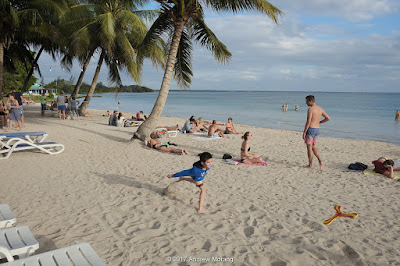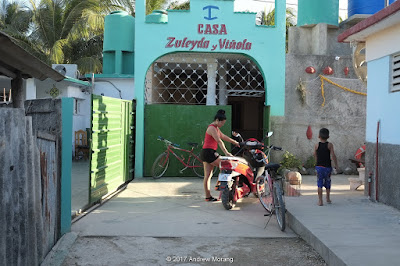 |
| Checking out the scene, Playa Larga, Cuba |
The US-sponsored invasion Bay of Pigs plays a large role in the history and mythology of the Cuban Revolution.
After reading about how the invading force flubbed up just about everything and how Cuban soldiers under the direction of Fidel Castro rounded up and arrested the demoralized invading force, I expected to see rusting military equipment and debris on the beaches at Playa Larga. Oops, now there are Europeans lounging around in small swim suits enjoying rum mojitos. Yes, I suppose even the Revolution must slowly adapt to the new economic reality.
The little town of Playa Larga, at the northwest tip of the Bahía de Cochinos or Batalla de Girón, was the
Red Beach landing site for the CIA-trained paramilitary group
Brigade 2506 on April 17, 1961. The beach proved to be floodlit, the boats grounded on coral reefs, and within three days, the Brigade 2506 was defeated by Cuban Army and militia forces. It was a tremendous embarrassment for President Kennedy, although the operation was hatched by the CIA and
approved by President Eisenhower long before Kennedy began his term.
Then Playa slumbered, but is slowly transforming itself into a tourist destination. I am not sure if there are any hotels, but there are numerous
casas particulares, which means private houses that have been certified to take in tourists. The one we stayed in was really more like a small inn rather than a private house, but someone on the staff did sleep in a tiny interior room. The staff was very courteous, the water was hot, towels clean, and our room faced the sea.
Despite the new tourists, much of Playa Larga looks like a place left in a previous time. The streets are sort-of paved. Local folks walk or take tricycle taxis. The rooster sings every morning (and much of the day and night, as well).
We walked around and came across a shop where the gents were restoring an old car. The next day it was gone, so I assume it ran on its own power. Cuban mechanics are pretty innovative considering the embargo for the last 50 years.
We were surprised that there was not much of a fishing fleet, just small open boats with outboards.
 |
| Propaganda in visitor's center at entrance to Playa Larga. |
 |
| Victory billboard in Bermeyas, near the Bay of Pigs military museum. |
 |
| Capitalist transportation in Playa Jardin |
 |
| Non-Capitalist transport in Playa Jardin |
Playa Larga is fun enough, and we had wonderful weather without mosquitos. We were on a birding group, and the Zapata Peninsula is fabulous for bird-watching. But I'm not sure if I would go to Playa for a beach vacation.
These are digital images from a Fuji X-E1 digital camera.


















































